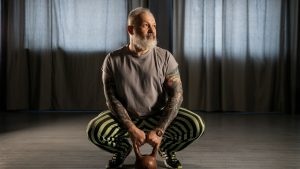As we age, maintaining balance becomes increasingly crucial for overall well-being, reducing the risk of falls and supporting functional movement. Squats are fantastic exercises to enhance balance, but the variation ideal for older adults involves considering their individual needs and limitations.

Factors to Consider
When selecting squat variations for older adults aiming to improve balance, consider these factors:
Mobility
Assess their hip, knee, and ankle mobility. Variations that accommodate limited range of motion are ideal.
Stability
Consider their current stability level. Some individuals may require additional support or modifications to perform squats safely.
Strength
Evaluate their leg strength to determine the appropriate resistance or bodyweight variation.
Ideal Squat Variations for Older Adults
1. Chair Squats
Benefits: Provides stability with a chair for support. Targets quadriceps and glutes.
How to: Sit on a chair, stand up, then sit back down, controlling the movement.
2. Bodyweight Squats
Benefits: Enhances leg strength and balance. Focuses on functional movement.
How to: Stand with feet shoulder-width apart, squat by bending the knees and hips, then return to standing.
3. Wall Squats
Benefits: Offers support and stability. Focuses on form and control.
How to: Lean against a wall with feet hip-width apart, slide down into a squat position, hold, and return to standing.

4. TRX Squats
Benefits: Utilizes suspension for support. Allows adjustment of difficulty.
How to: Hold onto TRX straps, lean back slightly, squat down while maintaining tension in the straps, then return to standing.
So.
Squat variations tailored to an individual’s mobility, stability, and strength levels are key. The chair squat, bodyweight squat, wall squat, or TRX squat can all contribute to better balance in older adults. However, it’s crucial to consult with a fitness professional or healthcare provider to determine the most suitable variation based on individual needs.
As we dive deeper into the realm of fitness and balance for older adults, it’s essential to understand the nuanced aspects that contribute to a well-rounded regimen.
Understanding Balance and Its Importance
Balance is more than just the ability to stay upright; it’s a complex interplay of various bodily systems. As we age, factors such as declining muscle mass, changes in sensory perception, and reduced coordination can affect balance. Therefore, integrating exercises like squats that focus on strength, stability, and mobility becomes vital.
Tailoring Squats for Individual Needs
Progressive Approach
For older adults new to squatting or those with limited mobility, starting with chair squats can lay a solid foundation. As their strength and confidence improve, progressing to bodyweight squats can be the next step.
Safety and Support
Safety precautions are paramount. Utilizing support, like a sturdy chair or a wall, allows individuals to perform squats with confidence while minimizing the risk of falls.
Customizing Difficulty
Adjusting the difficulty level based on individual capabilities is key. TRX squats, for instance, offer versatility by allowing users to modify the angle and intensity of the exercise.
Holistic Approach to Balance
While squats play a significant role, a holistic approach to balance training is recommended. Incorporating other exercises that target different aspects of balance, such as single-leg stands, heel-to-toe walking, and balance board exercises, can further enhance stability and coordination.
Importance of Professional Guidance
Always encourage older adults to seek guidance from fitness professionals or physical therapists. These experts can assess individual capabilities, provide personalized recommendations, and ensure exercises are performed correctly and safely.
Conclusion
In summary, squat variations tailored to an individual’s abilities can significantly improve balance in older adults. However, it’s crucial to approach fitness holistically, considering a range of exercises and seeking professional guidance. By doing so, older adults can enjoy the benefits of improved balance, reduced risk of falls, and enhanced overall well-being.
Are you interested in more details about specific balance exercises or further guidance on creating a well-rounded fitness routine for older adults?
For more detailed guidance on exercises for older adults, check out these resources:
National Institute on Aging – Go4Life Exercise and Physical Activity Guide
American Council on Exercise – Exercise Guidelines for Older Adults
Harvard Health Publishing – Better Balance for Older Adults
By incorporating suitable squat variations into a balanced fitness routine, older adults can enhance their balance, strength, and overall quality of life.
Comparison tabular
| Squat Variation | Benefits | How to Perform | Ideal for |
|---|---|---|---|
| Chair Squats | Provides stability with support, targets quads & glutes | Sit on chair, stand up, sit back down | Limited mobility, initial strength building |
| Bodyweight Squats | Enhances leg strength, focuses on functional movement | Stand, squat, return to standing | Improved mobility, moderate strength |
| Wall Squats | Offers support, emphasizes form and control | Lean against wall, slide into squat, return | Stability, form correction |
| TRX Squats | Utilizes suspension for support, adjustable difficulty | Hold TRX straps, squat with tension, return | Varied intensity, adaptable support |
Each squat variation caters to different needs, offering specific benefits and targeting various aspects of balance and strength for older adults. Choosing the right variation depends on individual capabilities and goals, ensuring a safe and effective exercise routine.
Wrapping up
Improving balance and strength in older adults is a journey that begins with tailored exercises like squats. By incorporating variations such as chair squats, bodyweight squats, wall squats, and TRX squats, individuals can address different levels of mobility, stability, and strength.
Remember, the key is to start where you’re comfortable and progressively challenge yourself. Always prioritize safety and seek guidance from professionals to ensure exercises are performed correctly and effectively.
Balance is not just about staying steady on your feet; it’s about confidence, independence, and a better quality of life. Embrace the journey toward better balance, and let these squat variations be your foundation for a more stable, active, and fulfilling life.

Hey there, it’s Mike Rrsq, the Editor-in-Chief over at Jsquat.com, and I’m absolutely obsessed with all things squat fitness! I’ve been lucky enough to get some serious recognition for my work in this field. With a solid background in the fitness and wellness industry, I’ve been there right from the get-go, helping shape this website into what it is today.
You see, I’m not just the boss around here; I’m also a passionate contributor. I love sharing my insights through my articles, and trust me, they’re not your run-of-the-mill stuff. Each piece I write is a labor of love, filled with my expertise and real-world experience in the fitness universe. So, if you’re into fitness and looking for some inspiration, you’re in the right place!
Related Posts
- How can Ballet Squat (Plie Squat) help improve balance
The ballet squat, also known as a plié squat, is a fantastic exercise for enhancing…
- Best 3 most effective squat variations you need for targeting the adductor magnus.
Squat is one of the most effective exercises that you can do to target quads…
- The Best 3 Most Effective Squat variations for targeting the obliques.
Squats are renowned for their ability to strengthen and tone the lower body, but did…
- Different squat variations That I Do (Explained)
Looking to spice up your squat routine? These are great different squat variations you need…
- Best 3 Most Effective Squat Variations you need for targeting the transverse abdominis.
When it comes to strengthening the core, especially the often elusive transverse abdominis, selecting the…
- The 3 most effective squat variations you need to do for targeting the biceps femoris.
When it comes to strengthening and targeting the biceps femoris, a key muscle in the…
- Best 3 Squat Variations that you need for Targeting the Vastus Intermedius
When it comes to sculpting and strengthening the lower body, incorporating various squat variations can…
- Why Can't I Maintain Balance When I Squat? (5 Reasons Why-Explained)
Struggling with maintaining balance while squatting? Don't worry, you're not alone! Discover the surprising reasons…
